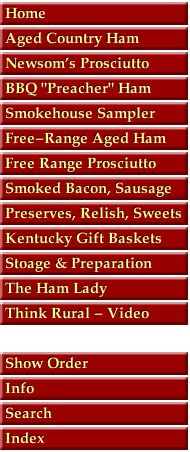
 What a ham! Kentucky makers have the cures to perfect your Derby feast April 21, 2010 The Courier-Journal By Ron Mikulak The Kentucky Derby and the mint julep are forever entwined. But should it also be permissible to do Derby without eating country ham? The rich, salty, essence-of-pork experience of true country ham has long been a culinary signature of Derby parties. Today, a resurgence of ham making is taking place in Kentucky so it is time to consider the pleasures of real dry-cured ham — and how to prepare it properly. Indeed, ham and bourbon are two of the first great artisanal culinary products perfected south of the Mason-Dixon line. At one time, every county around had a master distiller brewing up a unique blend of sour mash, and a master ham man (or lady) working out his or her own special cure for those fat pig legs hanging in the ham house. Over time, both ham making and bourbon distilling were absorbed into the maw of large corporations, and the products standardized to the dismay of aficionados who cherish the memory of different, localized approaches developed by small producers. In the last decade, however, artisanal approaches to both whiskey and ham production have surged, as individuals rediscover what our ancestors knew about how to coax top quality from local resources. A Common Process… It turns out that there are more than a few similarities between crafting bourbon and curing ham. When the artisan, be it a distiller or a ham maker, first sets out to perfect a product, basic decisions have to be pondered. Bourbon has to be made from at least 51 percent corn, but beyond that the mixture of grains — in the mash is up to the distiller, who makes a judgment about how the blend of corn, wheat, barley or other ingredients will affect the flavor of the end product. Likewise, there are just a few ways to cure a pig's leg to make it into a ham, but the decisions on the specific blend of techniques is a personal decision of the ham maker, guided by tradition, experience or imagination. Some hams are cured completely in salt, others with a mixture of salt and sugar. Some cures add pepper, and some add nitrates. Some hams are hung in a smokehouse to age, while other ham makers eschew smoke. Both bourbon and hams are aged, the best for more than a year. An "old" ham is 2 years old, but some might be aged up to 3. The ambient temperature over the course of aging affects both whiskey and meat. Summer heat expands bourbon in aging barrels, forcing the colorless neutral grain spirit that comes out of the still into the pores of the wooden barrels, where the whiskey picks up flavors and colors. In the fall and winter, the liquor contracts, pulling the liquid, and the flavors, out of the wood. Similarly, pigs used to be slaughtered only in the cold weather, the salt cures hand-rubbed into the meat, beginning the long, slow controlled fermentation during the winter months. Then, drink the "sweating season," the summer's heat liquified a ham's fat, and gravity pulls that liquid fat down through the flesh, imparting flavors and imbuing the meat with a silky texture. As it ages, bourbon will lose some mass through evaporation, the "angel's share." Hams, too, lose weight during aging. Indeed, ham must lose a minimum of 18 percent of its fresh weight during the curing and aging process to be legally sold as "country ham," and some specialty hams will lose up to 25 percent or more. ..…… Nancy Newsom Mahaffey cures fewer than 10,000 hams a year at Col. Newsom's Old Mill Store in Princeton. She has decided to remain a smaller operation, and to cure her hams in a more traditional way, using a family recipe handed down in a family will from Virginia in the late 1700s. "Sometimes, businesses get the desire to grow, to get big, and when they do, they have to water down their process," she said. "One reason why the ham business was commercialized is that once people built their facilities, they couldn't afford any downtime. They had to get bigger to keep what they had built." Newsom buys her pigs from a variety of hog producers, outside of Kentucky and from within the state. She starts all of her hams in January, hand-rubbing twice with a cure of brown sugar and salt, but no added sodium nitrate. Once the hams are hand-washed and taken out of the salt, they are hung in netting and aged at ambient temperatures, not climate controlled, and the rest of the process is a blend of art and science. Most of her hams hang, aging, for at least 10 months, gearing for sale at about a year old. Some are held for as long as two years. As they hang, they will lose between 22 percent and 32 percent of their original weight. "When the skin feels right, I smoke them with an iron kettle with green hickory, until they start looking right, from 10 to 20 days, depending on the weather and the humidity. Smoke is for both flavor and appearance, and a bit of added preservative," Newsom explained. Last fall, Newsom was invited to the 5th World Congress of Dry Cured Hams, held in Aracena, Spain, where one of her hams was selected to hang in the Jamon Museum in Aracena. Newsom's hams were among James Beard's favorite country hams, and Newsom was accorded a chapter in Peter Kaminsky's book "Pig Perfect: Encounters with Remarkable Swine and Some Great Ways to Cook Them." |